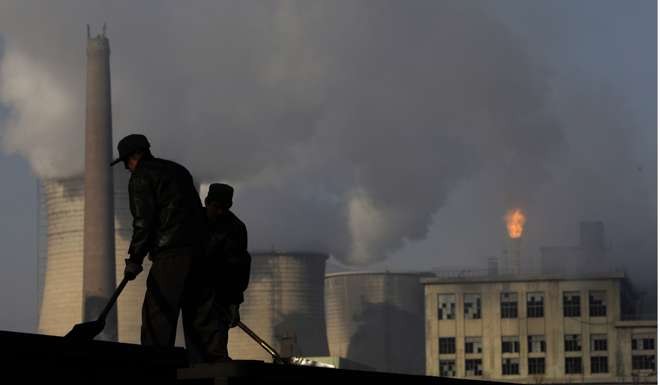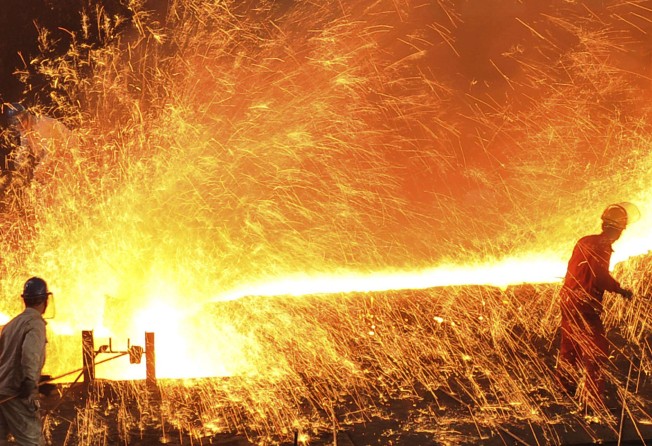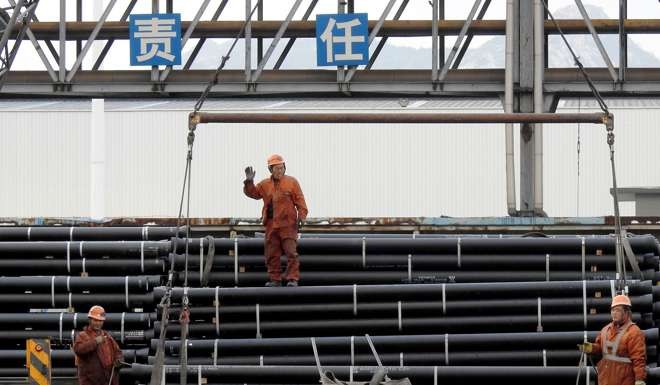
Is China’s bid to slash the size of its polluting steel and coal industries working?
Analysts have cast doubt on whether the cuts announced by the government will have any meaningful impact on production

China’s cabinet says it has “basically completed” its targets this year to reduce excessive production capacity in the nation’s steel and coal sectors, but analysts have questioned whether the government’s campaign will have any real impact.
Premier Li Keqiang ordered his ministers and local officials to shut down 45 millions tonnes of steel capacity this year and 280 million tonnes in the coal sector, with quotas allocated for each province to meet.
As the end of 2016 approaches, local officials have declared to Beijing they have done their part, leading the cabinet to say last week that the war against excessive capacity was “ahead of schedule”.
The move to cut the size of China’s coal and steel sectors comes as the government attempts to shift the focus of the nation’s economy away from heavy industry and cheap manufacturing in favour of the high tech and service sectors.
Beijing is also under pressure from trading partners including the European Union, who have accused China of dumping its glut of unwanted steel on their markets.
But a take deeper look at the government’s efforts to cut production capacity and the picture becomes much more murky.
First is the question of whether China’s official data accurately measures the true scale of the country’s hodgepodge network of coal and steel producers, according to industry researchers.
China’s steel plants if run at full steam can produce 1.3 billion tonnes of metal a year, far higher than the 1.2 billion tonnes reported by the government, according to Wei Yansong, an analyst at Mysteel, an industry group that tracks steelmaking.
As China’s output of crude steel was only 800 million tonnes last year, it meant about 500 million tonnes of production facilities remained idle in 2015 and so shutting down 45 million tonnes of capacity makes little difference to China’s actual steel production, according to Wei.
Julian Evans-Pritchard, a China economist at Capital Economics, also said efforts to reduce capacity were more a numbers game than a concerted attempt to scale back the coal and steel industries.

Beijing’s desire to control steel output can be traced back to the 1950s when Mao Zedong promoted the “Great Leap Forward” with the aim of transforming the country from an agrarian to an industrial economy.
A key element was to boost China’s crude steel output to match that of the US and Britain.
As communities melted down tools, pots, pans and other metalwork to make steel, the disastrous campaign contributed to one of the most devastating famines in human history.
Very often these capacity reductions are not real. They are temporary closures, and they are reversible
Decades later, however, after China’s economy was opened up to the world, it did overtake the US and Japan to become the world’s biggest steel producer by the late 1990s.
But the expansion soon began to worry the government, with fears that the nation was producing too much steel.
In one case, the government under former premier Wen Jiabao killed an ambitious new steel plant plan proposed by the private firm Tieben on the bank of Yangtze River in 2004.
Its boss was also thrown behind bars and local officials were disciplined for violating Beijing’s intention to control steel output.
Ironically, since the scheme was scuppered, China’s steel output has almost tripled. Crude steel output surged to 800 million tonnes last year compared with 270 million tonnes in 2004.
Beijing’s tough action against those who challenge or ignore its commands on industrial policy still continues, however.
In the latest example, the government is tearing down 12 blast furnaces at a steel plant in Xinyi in Jiangsu province and has detained more than 10 executives and steel dealers for unlicensed production, the state-run news agency Xinhua reported.
One result of the government’s efforts to control production capacity in the coal and steel sectors is that the two industries are increasingly in the hands of state-controlled conglomerates.
China just merged state-owned Wuhan Iron and Steel Group with Shanghai Baoshan Iron and Steel Group to create the world’s second biggest steel company.
Smaller players, usually privately owned and more adaptable to market changes, are usually the first targets of government crackdowns on production over safety and pollution concerns.
Regulations stipulate that the smallest production capacity allowed for steel plants is one million tonnes, with 300,000 tonnes for coal mines, forcing smaller firms to scale up their operations.
The recent rally in steel prices has also generated fresh challenges for the government to rein in private steel mills, which tend to ignore state mandates if there are profits to be made. The price of steel reinforcing bars, a common product used in the building industry, has risen over 50 per cent this year thanks to a recovery in the construction sector.
ANZ senior economist Raymond Yeung said that only by permanently closing lines of production could the government’s programme be deemed a success.

The coal sector faces more pressure under China’s clean energy drive.
Bejing has promised to raise the nation’s use of non-fossil fuels to 15 per cent of its total energy production by 2020.
Coal is widely blamed for air pollution as coal-fuelled power stations account for nearly 70 per cent of China’s electricity supply. Heating systems powered by the fuel are also in widespread use in northern regions in the winter.
China’s aggressive coal capacity cuts have, however, backfired this year.
Prices of the fuel have risen 40 per cent amid shortages of supply. The benchmark coal price at Qinhuangdao port is approaching a near three-year high and there is no sign of this trend stopping.
The bump in prices has led to questioning over the impact of government intervention in key industries and whether the authorities will try to tackle overcapacity in other sectors in the coming years such as aluminium, cement, shipbuilding and papermaking.
Teng Tai, the head of the research house the Winbro Economic Research Institute, told a forum last week: “We hope the government will change itself first rather than intervene in the market in next year’s supply-side reforms.”